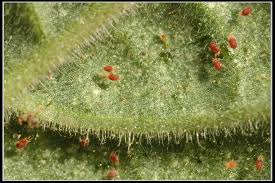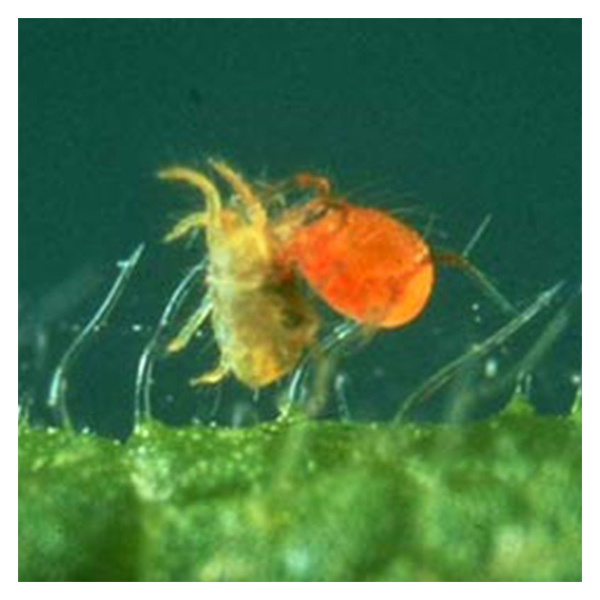How to Effectively Control Mites in English Cucumber Cultivation
Introduction

Mites, particularly spider mites (Tetranychus spp.), are a major problem in English cucumber cultivation, especially under warm and dry conditions. Their rapid reproduction and webbing make them difficult to control. Let’s discuss five practical strategies that cucumber growers can implement to manage mite infestations effectively.
1. Physical Barriers: Stopping Mites Before They Spread
Preventing mites from entering the crop area is the first step in effective control.
High-Pressure Water Spray
- Mites thrive in dry conditions. Regular overhead misting can physically dislodge them from leaves.
- In polyhouse cultivation, maintaining 70–80% humidity can significantly reduce mites populations.
Reflective Mulching
- Silver or aluminum mulch reduces mite movement between plants and soil.
- Works best when applied at the early growth stage.
Sticky Traps for Monitoring
- Yellow sticky traps is more effective in attracting mites.
- Placing them at plant canopy height can minimize mites population before they spread widely.
2. Biological Control: Encouraging Natural Predators
Beneficial mites and insects can naturally suppress mite populations.
Predatory Mites (Phytoseiulus persimilis)
- This predator feeds on spider mites at all stages.
- Releasing 2–5 mites per plant for effective control in polyhouses.
Lacewings and Ladybird Beetles

- Lacewing larvae and ladybugs consume mite eggs and larvae.
- These predators thrive in organic and low-chemical farming systems.
Entomopathogenic Fungi (Beauveria bassiana, Hirsutella thompsonii)
- These fungi infect and kill mites upon contact.
- Spray at 5 g per liter in humid conditions for better results.
3. Cultural Practices: Reducing Mite Favorable Conditions
Adopting the right farming practices can significantly lower mite infestations.
Avoiding Dry and Dusty Conditions
- Frequent light irrigation or misting reduces dust buildup, making plants less attractive to mites.
Removing Weeds and introducing Alternate Hosts
- Mites breed on weeds like amaranthus, chickweed, and solanaceous plants.
- Regularly removing weeds reduces hiding spots.
Trap Crops
- Marigold and castor plants attract mites away from cucumbers.
- Placing trap crops at the edge of fields prevents mites from reaching cucumbers.
4. Targeted Chemical Control: Strategic Spraying for Mites
Since mites develop resistance quickly, using the right acaricides in rotation is key.
Preventive Spray (Early Crop Stage)
- Neem oil (Azadirachtin 1500 ppm) – 2 ml per liter reduces egg-laying.
- Sulfur 80 WP (2 g per liter) disrupts mite growth and is safe for natural predators.
Combating Moderate Infestation
- Abamectin 1.9 EC (0.5 ml per liter) + Neem oil (1 ml per liter)
- Applying every 7–10 days if mite activity is increasing.
Managing Severe Infestation
- Spiromesifen 22.9 SC (1 ml per liter) + Fenpyroximate 5 SC (1 ml per liter)
- This combination targets both adult and larval mites.
- Spraying early morning or late evening for better penetration.
Application Best Practices
- Always using spreader-sticker to improve spray adherence on leaves.
- Avoiding continuous use of the same acaricide to prevent resistance.
5. Resistance Management: Ensuring Long-Term Mite Control
Acaricide resistance is a common issue, so a proper rotation plan is essential.
Rotating Chemical Groups
- A recommended cycle:
- Abamectin → Spiromesifen → Fenpyroximate → Propargite
- Avoiding back-to-back use of the same mode of action.
Reducing Pyrethroid Usage
- Pyrethroids (e.g., cypermethrin) kill beneficial predators and lead to mite flare-ups.
Using Adjuvants
- Non-ionic surfactants enhance mite control by improving spray coverage.
Conclusion
Mite management in English cucumber requires an integrated approach combining physical barriers, biological control, cultural practices, and strategic acaricide applications. A well-planned strategy helps maintain plant health, reduces yield losses, and minimizes pesticide resistance risks.
By adopting these measures, we can keep mite infestations under control while maintaining an eco-friendly farming system. This is only my experience and point of view after discussing with the local farmers who have quite a good experience of knowledge in this topic. Have you tried any of these methods? Let’s discuss your experiences in the comments!


